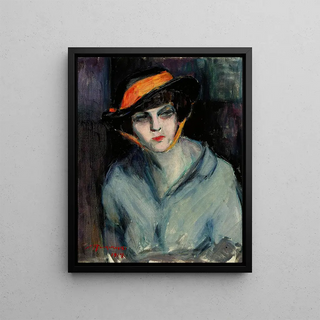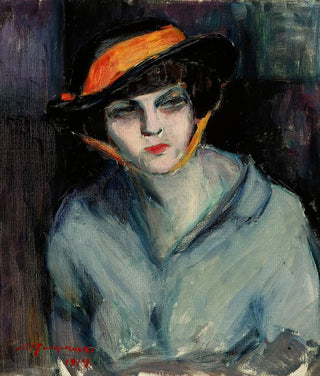Art print | Woman wearing a hat - Jalmari Ruokokoski


View from behind

Frame (optional)
The art print "Woman wearing a hat" by Jalmari Ruokokoski presents itself as an iconic piece that transcends mere portraiture to capture the very essence of femininity and elegance. This work, created in the early 20th century, embodies the Finnish artistic movement while fitting into a broader tradition of female representation in art. The delicate silhouette of the woman, highlighted by an extravagant hat, evokes an atmosphere of mystery and sophistication. This painting, through its harmonious composition and vibrant colors, draws the eye and invites deep contemplation, turning each observation into a new discovery.
Style and uniqueness of the work
Ruokokoski's style is distinguished by its bold use of colors and its ability to play with light. In "Woman wearing a hat," the chosen hues create a striking contrast between the background and the subject, emphasizing the presence of the woman at the center of the canvas. The artist's technique, blending impressionism with elements of realism, captures not only the external appearance of the model but also a palpable emotion emanating from her gaze. This gaze, both direct and enigmatic, seems to tell a story, engaging the viewer in a silent dialogue. The composition, centered and balanced, highlights the hat, a true centerpiece of the work, symbolizing not only the fashion of the time but also a certain social status. Every detail, from the draping of the dress to the ornaments of the hat, is carefully thought out, demonstrating a meticulous attention to detail that is characteristic of Ruokokoski.
The artist and his influence
Jalmari Ruokokoski, born in 1860, is an artist whose work is part of the Finnish art movement of the early 20th century. Influenced by the great European masters, he developed a distinctive style that combines tradition and modernity. His career, marked by success, allowed him to explore various themes, but it is undoubtedly the depiction of women that earned him particular recognition. By highlighting strong and expressive female figures,

Matte finish

View from behind

Frame (optional)
The art print "Woman wearing a hat" by Jalmari Ruokokoski presents itself as an iconic piece that transcends mere portraiture to capture the very essence of femininity and elegance. This work, created in the early 20th century, embodies the Finnish artistic movement while fitting into a broader tradition of female representation in art. The delicate silhouette of the woman, highlighted by an extravagant hat, evokes an atmosphere of mystery and sophistication. This painting, through its harmonious composition and vibrant colors, draws the eye and invites deep contemplation, turning each observation into a new discovery.
Style and uniqueness of the work
Ruokokoski's style is distinguished by its bold use of colors and its ability to play with light. In "Woman wearing a hat," the chosen hues create a striking contrast between the background and the subject, emphasizing the presence of the woman at the center of the canvas. The artist's technique, blending impressionism with elements of realism, captures not only the external appearance of the model but also a palpable emotion emanating from her gaze. This gaze, both direct and enigmatic, seems to tell a story, engaging the viewer in a silent dialogue. The composition, centered and balanced, highlights the hat, a true centerpiece of the work, symbolizing not only the fashion of the time but also a certain social status. Every detail, from the draping of the dress to the ornaments of the hat, is carefully thought out, demonstrating a meticulous attention to detail that is characteristic of Ruokokoski.
The artist and his influence
Jalmari Ruokokoski, born in 1860, is an artist whose work is part of the Finnish art movement of the early 20th century. Influenced by the great European masters, he developed a distinctive style that combines tradition and modernity. His career, marked by success, allowed him to explore various themes, but it is undoubtedly the depiction of women that earned him particular recognition. By highlighting strong and expressive female figures,






